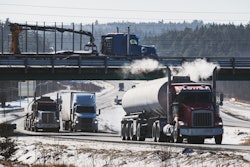The White House on Tuesday unfurled its U.S. National Blueprint for Transportation Decarbonization, outlining the Biden administration's framework for cutting transportation emissions.
Developed by the Departments of Energy (DOE), Transportation, Housing and Urban Development and the Environmental Protection Agency (EPA), the Blueprint is a strategy for cutting all greenhouse emissions from the transportation sector by 2050. The transportation sector – accounting for all modes of travel via land, air and sea to move people and freight —accounts for one-third of all domestic greenhouse gas emissions.
“The domestic transportation sector presents an enormous opportunity to drastically reduce emissions that accelerate climate change and reduce harmful pollution,” said U.S. Secretary of Energy Jennifer M. Granholm. “DOE is prepared to implement this Blueprint alongside our partners within the Biden-Harris Administration to ensure all Americans feel the benefits of the clean transportation transition: good-paying manufacturing jobs, better air quality and lower transportation costs.”
It's been an active few weeks for the Biden Administration and clean air policies.
The EPA in late December updated emission standards for heavy-duty commercial vehicles for the 2027 model year, tightening tailpipe NOx limits to a level of 80%-plus below the current standard. Last week, it proposed tighter particulate matter/soot regulations, citing health concerns that the fine particles penetrate deep into the lungs and can result in serious health effects that include asthma attacks, heart attacks and premature death.
The 88-page Blueprint will be followed by more detailed decarbonization action plans, to be developed and implemented by these agencies in cooperation with governments at the state, local and Tribal levels, philanthropic organizations, the private sector and global partners, and lays out to strategic pathways for any transportation modes. While it doesn't recommend actions or make directives, the Blueprint does, however, infer that trucking's path to zero emissions will not likely include a significant period of time devoted to near-zero emissions.
A memorandum of understanding signed in September among all the partner agencies notes that for heavy duty vehicles, the group would seek to "identify and remove barriers to the use of hydrogen fuel cells and related infrastructure" and "coordinate work that supports transformations of the electrical grid, charging infrastructure investments, and equitable, fair use of rights-of-way to support increased on-road vehicle electrification," while "[accelerating] utility, automotive, truck, fleet and electrical equipment manufacturer collaboration on smart electric vehicle charging to leverage the synergies between the transportation and power systems."










